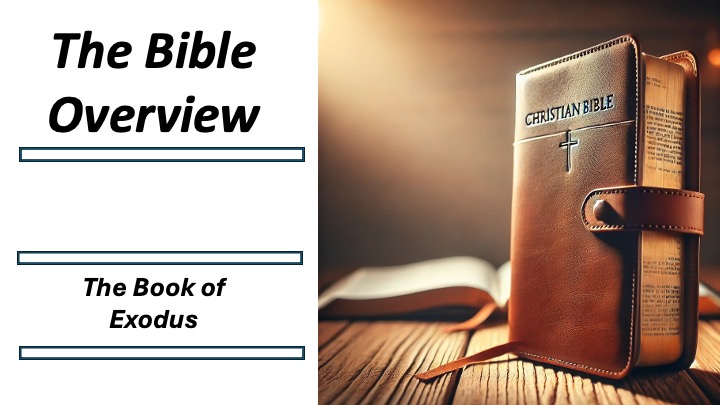Bible Overview Exodus
Mike Ervin

Book of Exodus: Study Overview
1. Authorship
• Traditional View:
• Attributed to Moses as part of the Torah (Pentateuch) (Exodus 17:14; 24:4).
• Supported by Jewish and Christian tradition.
• Scholarly View:
• Many scholars believe Exodus was compiled from multiple sources (e.g.,
Yahwist, Elohist, Priestly traditions).
• Likely finalized during the exilic/post-exilic period (6th–5th century BCE).
2. Date of Authorship
• Event Timeline (If Historical Exodus Occurred):
• The Exodus itself is debated, with two proposed dates:
• Early Date: c. 1446 BCE (based on 1 Kings 6:1, linking it to Solomon’s
reign).
• Late Date: c. 1260 BCE (based on archaeological evidence of Egypt’s influence
in Canaan).
• Date of Composition:
• If Mosaic authorship: 15th–13th century BCE.
• If compiled later: 7th–5th century BCE.
3. Intended Audience
• Ancient Israelites:
• Originally addressed to those entering or living in the Promised Land.
• Served as a historical record, covenant reminder, and national identity
foundation.
• Later Generations:
• Reinforces faith in God’s deliverance, law, and presence.
4. Major Themes
1. Deliverance and Redemption
• God rescues Israel from slavery, showing His power over earthly rulers.
2. Covenant and Law
• The Mosaic Covenant (Exodus 19–24) establishes Israel as God’s chosen people.
• The Ten Commandments (Exodus 20) lay the foundation for moral and civil law.
3. God’s Presence and Guidance
• God leads Israel through the pillar of cloud/fire and the Tabernacle (Exodus
40).
4. Judgment and Mercy
• Egypt’s plagues demonstrate judgment.
• The Passover (Exodus 12) shows salvation through blood sacrifice.
5. Worship and Obedience
• Israel is called to worship God alone and follow His commands.
• The Golden Calf incident (Exodus 32) highlights human rebellion.
5. Sequential Review of Chapters
(Organized into major sections for PowerPoint clarity)
I. Israel’s Oppression and Deliverance (Chapters 1–15)
• 1: Israelites enslaved in Egypt.
• 2–4: Birth and calling of Moses.
• 5–11: Plagues upon Egypt.
• 12–13: Passover and Exodus from Egypt.
• 14–15: Red Sea Crossing and Song of Deliverance.
II. Journey to Mount Sinai (Chapters 16–18)
• 16: Manna and Quail provided.
• 17: Water from the rock.
• 18: Moses delegates leadership.
III. Covenant and Law at Sinai (Chapters 19–24)
• 19: Arrival at Mount Sinai.
• 20: The Ten Commandments.
• 21–23: Civil and moral laws.
• 24: Covenant ratified with blood.
IV. Instructions for the Tabernacle (Chapters 25–31)
• 25–27: Tabernacle design.
• 28–29: Priestly garments and consecration.
• 30–31: Sabbath laws.
V. Israel’s Rebellion and God’s Mercy (Chapters 32–34)
• 32: The Golden Calf incident.
• 33: Moses intercedes for Israel.
• 34: Renewal of the Covenant.
VI. Tabernacle Construction and God’s Presence (Chapters 35–40)
• 35–39: Tabernacle built.
• 40: God’s glory fills the Tabernacle.